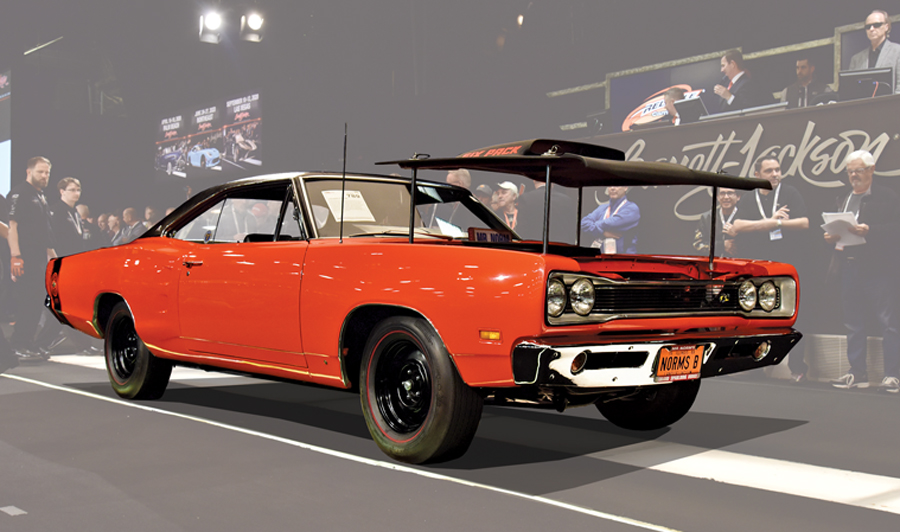- Real “Mr. Norm’s” Super Bee A12 Six Pack
- Sold at Grand-Spaulding Dodge in Chicago
- Period-correct 440-ci Magnum Six Pack
- Edelbrock aluminum manifold
- Triple Holley carburetors
- Matching-numbers 4-speed manual transmission
- Super Trak Pak Dana 60 axle
- Lift-off fiberglass hood
- Hubcap, power steering and power brakes delete
- Correct H-code wheels
- Original broadcast sheet
- Original fender tag
- Original radiator-support stampings
- Signed by Norm Krause
SCM Analysis
Detailing
| Vehicle: | 1969 Dodge Super Bee A12 |
| Years Produced: | 1969 |
| Number Produced: | 1,907 |
| Original List Price: | $3,539 |
| SCM Valuation: | $79,000 |
| Tune Up Cost: | $600 (estimated) |
| Chassis Number Location: | Plate at base of windshield |
| Engine Number Location: | On upper left front area of block |
| Club Info: | 1968 Dodge Hemi Super Bee, 1970 Dodge Challenger R/T 440 Six Pack, 1966–67 Plymouth Hemi Belvedere |
| Investment Grade: | B |
This car, Lot 789, sold for $117,700, including buyer’s premium, at Barrett-Jackson’s auction in Scottsdale, AZ, on January 16, 2020.
San Francisco may have been full of music, love and flower power in 1969, but on the mean streets of Chicago, near Grand-Spaulding Dodge, an entirely different kind of social evolution was under way: racing on the streets.
Each year during the 1960s, Detroit automakers kicked out ever-more-exciting products to entice new customers. And of course, the boardroom executives were driven to dominate the sales charts. They did it in the most innovative way — by helping their customers feel like they were dominating the streets.
A rare Bee
The Super Bee Six Pack was a bare-bones machine designed to win, which is evident in its details, such as NASCAR-style hood pins. The invention probably granted owners a sore back from lifting that big ping-pong-table-sized hood off the car whenever they wanted to check the oil. But the point was to show that this car’s only job was to shut the other guy down, whether on street or strip.
The inconvenience of having to remove the hood for inspection or service, plus the intentional lack of hubcaps, power brakes and power steering in the Six Pack (also known as the “A12 package” or “M code,” per the VIN plate), meant that this car was all about business. When this is your car, you’re the boss.
In reality, such minor mods would only incrementally help performance. Eliminating the power losses associated with driving a power steering pump via pulleys and V-belt would result in only fractionally more vroom going to the rear wheels (via 4.10:1 gears in this case), and the weight loss from the missing hubcaps, steering pump and brake booster assembly would likewise improve the power-to-weight ratio only slightly. And so, quite likely, omitting these components had more to do with making the Super Bee affordable during the peak muscle-car years, and to give it the right image. “Super Bee can lower your E.T. and your payments at the same time,” said a period Dodge ad.
Deep, dark secrets
Just 1,907 Super Bee A12 Six Pack cars were built as special orders in mid-1969 only. The Super Bee Six Pack included an Edelbrock aluminum intake manifold supporting three 2-barrel Holleys on top of the 440-ci Magnum V8 — hence the “Six Pack” name. The 440 also boasted a special camshaft, 10.5:1 pistons, magnafluxed connecting rods, and a dual-point distributor. Rated output was 390 hp and 490 ft-lb of torque.
Other Six Pack ingredients included the customer’s choice of a heavy-duty TorqueFlite automatic or a 4-speed manual gearbox with a Hurst Competition/Plus shifter, a Dana 60 Sure Grip axle, the aforementioned matte-black lift-off fiberglass hood with its cavernous scoop, heavy-duty 11-inch drum brakes, and bare black 15-by-6-inch steel wheels wrapped in G70-15 Polyglas Redline tires.
One thing’s for sure — the Hemi Orange paint on this particular lot was just about as wild as you could get in period. It’s right in there with Plum Crazy, Top Banana and Panther Pink, also offered by Mopar.
Done to the nines
This restoration looks superb, with nary a misfitted piece of carpet nor a wayward wrinkle in the upholstery. Non-original, date-coded blocks are broadly accepted in show judging today, which is a good thing, because this car lost its original engine and has instead a “period-correct” date-coded unit. However, the original manual transmission remains.
While quick, this isn’t a small or nimble car by today’s standards. It’s over 17 feet long with a 117-inch wheelbase, and weighs some 3,435 pounds. It may shut your buddy down on the way to Dead Man’s Curve, but after that it would be all over against any Sting Ray or XKE that you encountered.
However, unlike such relatively smaller coupes, the Super Bee could also make a viable highway ride (if not for its 4.10 gears — but a bolt-on change to 3.70 or so wouldn’t tank the car’s value). But that steep ratio brings us back full circle, to the intent of this car from the get-go: short bursts of brutal acceleration on street or strip.
This car started life at Grand-Spaulding Dodge, home of the well-known “Mr. Norm’s” drag-racing efforts, which can be a real plus for the right Mopar-crazy buyer. That Mr. Norm sticker, mounted to the side glass, brings another level of street cred to a car that wasn’t missing any to start with.
Mr. Norm provenance does add value on top of this car’s condition, too. All things considered, I think this was a good buy, even at 49% above the ACC Pocket Price Guide’s current median value. Call this one beautifully restored and brilliantly sold.
(Introductory description courtesy of Barrett-Jackson.)
